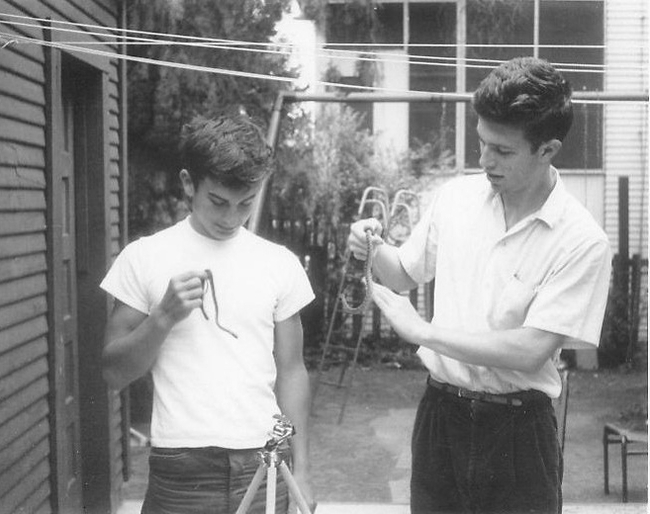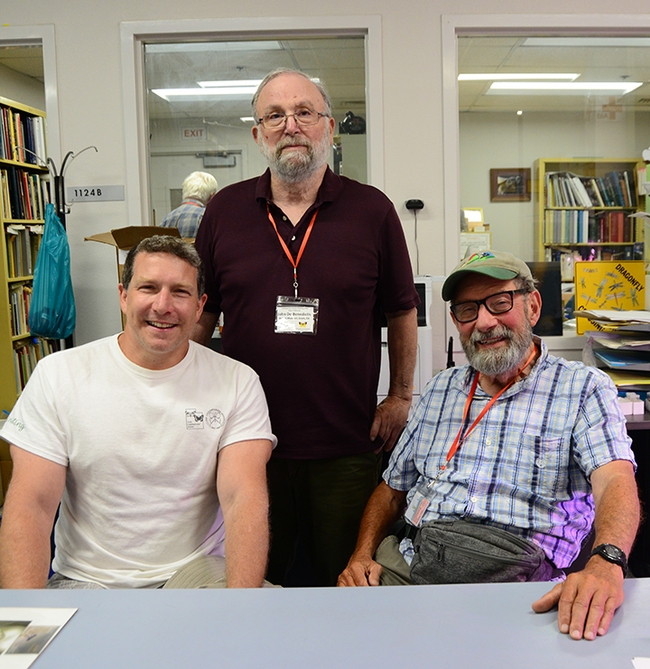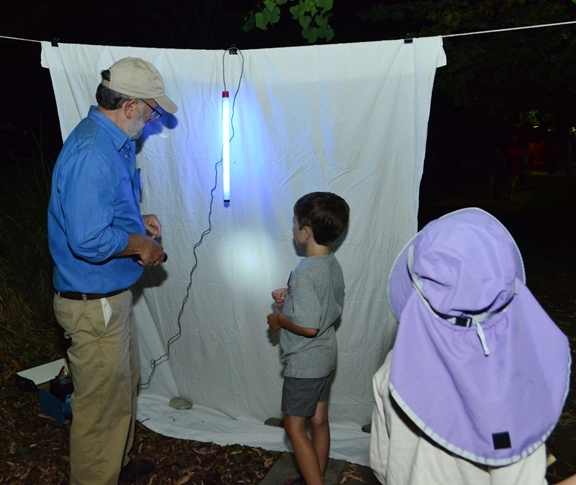
If you attend the Bohart Museum of Entomology's annual Moth Night celebration, affiliated with National Moth Week, you'll meet John De Benedictis, better known as “The Moth Man.”
The indoor-outdoor event, free and open to the public, is set from 7 to 11 p.m., Saturday, July 20 in Room 1124 of the Academic Surge Building, 455 Crocker Lane.
De Benedictis and his colleagues annually set up a blacklighting display, using UV lighting to attract moths and other night-flying insects. He has blacklighted for 37 years.
His moth collection of some 600 species from the Stebbins Cold Canyon Reserve and 300 species from his backyard in Davis is housed in the Bohart Museum.
"Jerry Powell (the late UC Berkeley professor and director of the Essig Museum of Entomology) once estimated that there are about 17,000 North American butterflies and moths," De Benedictus commented. "I would not be surprised if it's closer to 20,000."
'Expertise in Moth Identification Is Invaluable'
"John has been great volunteer and supporter of the Bohart Museum," said UC Davis distinguished emerita professor Lynn Kimsey, former director of the Bohart Museum. "His expertise in moth identification is invaluable and now that Jerry Powell is gone, there's really no one else who can identify moths, particularly little brown moths (LBMs) of California."
De Benedictis, a research associate at the Bohart Museum, is closely linked to UC Berkeley, his alma mater, and UC Davis, where he retired. He holds a bachelor's degree in biology, with an emphasis in entomology (1979), and a master's degree in entomology (1998) from UC Berkeley. "Jerry was my major professor and also recruited me as an undergraduate to work in his lab."
A UC Davis retiree since 2001, De Benedictis worked as a staff research assistant from 1995 to 2001 in the laboratory of medical entomologist Tom Scott, UC Davis Department of Entomology and Nematology.
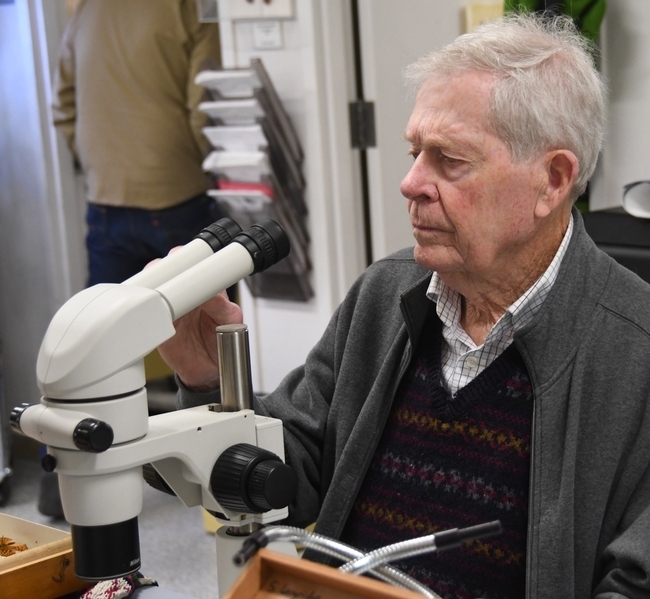
"I came to Davis in 1989 for a two-month job to key out aphids for Beth Grafton-Cardwell, who at that time was a postdoc of (Professor) Jeffrey Granett. During that time, the rootstock that was being used to protect wine grapevines from grape phylloxera began to fail in Napa and Sonoma counties, so I was able to prolong my stay at Davis through a series of grants to address that problem. While working for Beth and Jeffrey, I got a mini-grant from the former Institute of Ecology to study moths at the Stebbins Cold Canyon Reserve where I collected from 1989 until the last major fire in 2020."
“I began a similar inventory of the species in my backyard after I purchased my home in 1998," De Benedictis said. "It continues to this day, and a synoptic collection of the 300 or so species that I've collected in my yard is housed alongside the Cold Canyon collection in the Bohart Museum.” Grace Horne of the lab of urban landscape entomologist Emily Meineke, Department of Entomology and Nematology, is analyzing the data from these studies as part of her doctoral research.
When Children Were 'Free-Range'
John traces his interest in entomology to his childhood. Born in Oakland in 1945, the second of six children on Aldo and Eleanor De Benedictis, he grew up in Berkeley.
“I am grateful that I had parents who not merely tolerated but encouraged our activities and to have grown up in an era when chickens were confined and children were free-range rather than the reverse as is the case today.”
“I attended Berkeley public schools and later UC Berkeley, except for my last year of junior high school which was in Mt. Vernon, N. Y., while my dad was temporarily transferred,” De Benedictis said. “My older brother Paul was keenly interested in natural history, which switched from subject to subject whenever a new Golden Nature Guide came out. We spent much of our free time poking around in the East Bay Regional Parks and in Strawberry Canyon behind Berkeley's Central Campus.” (Paul went on to obtain a doctorate in ecology in Michigan.)
While in the fourth grade, John began “collecting butterflies, a few flashy moths, and other insects with my older brother and a couple of classmates. A highlight of my youth was the return trip from New York by car where we chased butterflies that we never saw in New York or in California as often as we could complain long and loud enough to make my dad stop the station wagon.”
When John was attending junior high in the late 1950s, he found a Polyphemus moth under a streetlight on the UC Berkeley campus. “It was a highly prized find. At UC Berkeley, we collected on spring field trips with the systematics professors and students and we---whoever was participating--ran lights on during our spruce budworm field trips. I ran a sheet a few times on San Bruno Mountain on my own and was surprised to find that very few of the moths that I had reared from caterpillars flew to my light. While in grad school and afterwards, I went on a few of Jerry Powell's trips to the California Channel Islands to assist him in his inventory of the islands' Lepidoptera species. There we ran lights and set out light traps when it wasn't too cold and windy.”
Species Named for Him
De Benedictis recalled that he and Dave Wagner, now a professor at the University of Connecticut, started graduate studies with Powell at UC Berkeley at the same time. "Jerry had a long-term project studying larval host plants of caterpillars, and Dave and I were among the succession of students who took care of his larval rearing lots on the Berkeley campus. Dave went on to become the current authority on the caterpillars of large moths. I was more interested in smaller moths and prolonged my graduate years by collecting caterpillars on San Bruno Mountain by the San Francisco Airport.” There De Benedictis discovered a handful of new species, one of which Powell named Gnorimoschema debenedictisi.
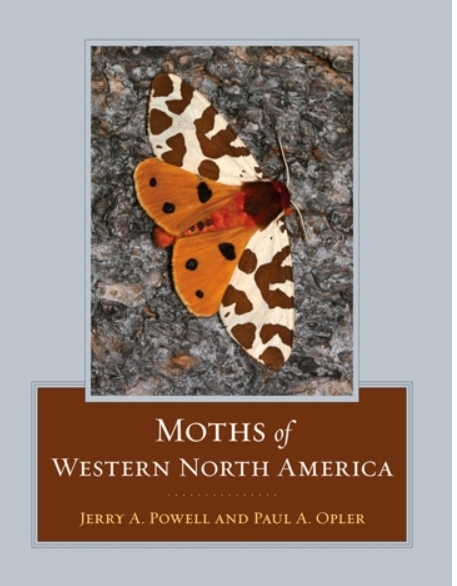
“The Mid-Winter Gathering is a legacy of Jerry Powell,” said De Benedictus, who spent more time in the field with Powell than any other UC Berkeley graduate student. "I was privileged to be Jerry's student and lucky to have him become my friend."I
In a tribute to Powell, the Essig Museum wrote: "Jerry's rearing program was the most extensive in the history of the study of New World Microlepidoptera. For over 50 years he and his students processed more than 15,000 collections of larval or live adult Lepidoptera. Resulting data encompass more than 1,000 species of moths, through rearing either field-collected larvae or those emerging from eggs deposited by females in confinement. This total includes more than 60% of an estimated 1,500 species of Microlepidoptera occurring in California."
Powell and Paul Opler, two Lepidoptera legends, co-authored Moths of Western North America.
Attached Images:
